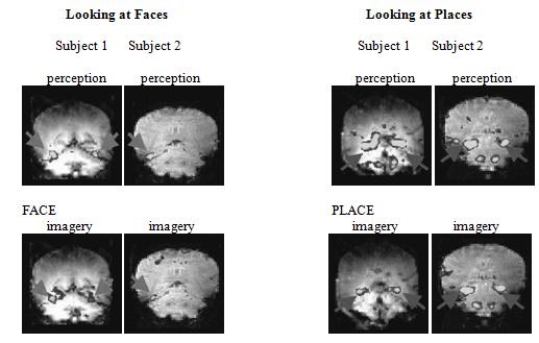Multiple Choice
Shown here are the fMRIs of the brain activity in two participants whilethey looked at photographs of familiar faces and places (top row-perception) or imagined the same pictures (bottom row-imagery) .According to the Focus on Neuroscience box, "Seeing Faces and Places inthe Mind's Eye," what do these fMRIs demonstrate? 
A) The fusiform facial area is activated when either looking at familiar faces or imagining them, and the parahippocampal place area is activated when either looking at familiar places or imagining them.
B) Totally different brain areas are active when participants look at objects (familiar faces or places) compared to when they imagine the same objects.
C) There is virtually no brain activity in the fusiform facial area or the parahippocampal place area when participants are looking at familiar faces or places (perception) but very high levels when the participants are imagining familiar faces or places (imagery) .
D) There is a very high level of brain activity in the fusiform facial area and the parahippocampal place area when participants are looking at familiar faces or places (perception) but very low levels when the participants are imagining familiar faces or places (imagery) .
Correct Answer:

Verified
Correct Answer:
Verified
Q60: Forming a mental image of a face
Q61: Which of the following is NOT a
Q62: In comparing the average IQ for various
Q63: Many psychologists today believe that the worldwide
Q67: Standardization is the process of administering a
Q68: Emily created a new sentence that neither
Q69: As discussed in the chapter Prologue, Tom
Q127: Thinking and behavior directed toward attaining a
Q165: Thinking often involves the manipulation of two
Q394: Dr. Milovitch systematically mixed thousands of different